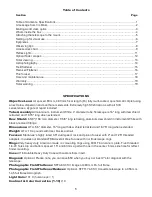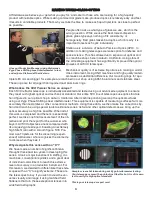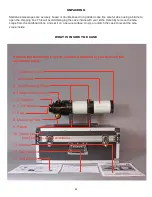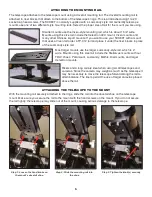
7
Eyepieces
:
While the telescope’s light-gathering power depends on the size of the telescope’s
objective lens, its magnification power depends on the eyepiece used. In order to see objects clearly
at the proper magnification power, we recommend having four or more eyepieces.
1. Low-power, wide-field eyepiece
:
You need a low-power, wide-angle eyepiece to more easily
locate objects in the sky and to observe extended objects like the Andromeda galaxy. Our best wide
field eyepiece is the Stellarvue Optimus 20.
2. Medium-power eyepieces
:
Boosting the power darkens the sky background and shows more detail in deep
sky objects such as nebulae, star clusters and galaxies. We recommed the Stellarvue Optimus 9 and 13.5
eyepieces as the best for medium-power deep sky viewing.
3. Two High-power eyepieces
:
Viewing planets, close double stars, and small craters on the moon requires a
high-power eyepiece. We recommend having two high-power eyepieces because the atmospheric seeing con-
ditions cannot always support the highest power. Having two high-power eyepieces of different focal lengths
will allow you to adjust the magnification based on the seeing conditions. We recommend the Optimus 3.6 and
4.7 eyepieces.
The amount of magnification is determined by dividing the focal length of
the telescope by the focal length of the eyepiece. The SVX80T has a 980
mm focal length. A 20 mm eyepiece, when used with this telescope, will
provide a magnification of 24 power (480 mm/20 mm). This means objects
appear 24 times closer. The smaller the focal length of the eyepiece, the
higher the power becomes. So our 4.7 mm eyepiece provides 102 power
(48mm/4.7mm).
The ability of a telescope to magnify is limited by:
A. The accuracy of the optics
B. The steadiness of the atmosphere
Under perfect conditions the SVX80T is capable of magnifying
objects 20 - 300 times. Unfortunately, the air is often unsteady
due to air turbulence. This causes the stars to twinkle and limits
the ability of any telescope to show fine details. Adding more
power only increases the size of the burry image. This is referred
to as “empty magnification” since it is too high of a power for the
conditions and actually shows you less. Under turbulent condi-
tions, it is best to use a lower magnification eyepiece.
If you purchased the entire set of Optimus eyepieces you may
notice that on a given night the planetary views through the 3.6
mm eyepiece may be soft. This indicates that the seeing condi-
tions are not optimal, so it is wise to switch to the 4.7 mm eye-
piece. The image will be smaller but sharper.
Stellarvue optics are extremely accurate. If details are soft when
you observe through it, you either did not let the optics cool down
enough or you are observing under less than favorable condi-
tions. Be patient. On a steady night you will see magnificent de-
tail.
Magnification is not as important on larger extended objects.
Many amateur astronomers switch from planets to star clusters
and nebulae when the air is unsteady.
Jupiter appears sharp under steady skies and its
moons appear as disks.
Unsteady air distorts the moons
and Jupiter is soft with little detail
OPTIMUS EYEPIECES






































